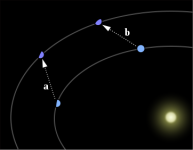Here, "inner" and "outer" are relative to a planet's orbit, so Venus is an outer planet relative to Mercury and Jupiter an inner planet relative to Saturn.
From celestial mechanics, the lowest-order precession rates are
w(prec) = (3/4)*(m/msun)*w(orb)*(ax/a)
2 for an inner planet and
w(prec) = (3/4)*(m/msun)*w(orb)*(a/ax)
3 for an outer planet.
(pericenter direction: forward, nodes: backward) (planet's major axis: a, other planet's major axis and mass: ax, m)
The general expression is this rather nightmarish integral:
w(prec) = (1/2)*(m/msun)*w(orb)*a
2*ax * (1/pi)*integral of cos(p)/(a
2 + ax
2 - 2*a*ax*cos(p))
3/2 over p from 1 to pi
That can be done with elliptic integrals, though it is easy to calculate it numerically.
For completeness, the effects of the other planet's eccentricity and inclination must also be included, but I'm ignoring that for now. They have similar expressions, however.
-
Now for Mercury's excess perihelion precession. It is 43 seconds of arc per century, or 8.0*10
-8 of Mercury's average angular velocity or "mean motion".
That is in very good agreement with general relativity, which predicts (3*gravconst*msun)/(a*(1-e
2)*c
2) = 8.0*10
-8 here.
But here are estimated planet masses as a function of relative major axis:
- 0.75 -- 0.013
- 0.5 -- 0.082
- 0.25 -- 0.50
- 0.2 -- 0.82
- 0.15 -- 1.5
- 0.1 -- 3.5
So an intra-Mercurian planet that makes that extra precession should be large enough to observe.
But if it is a lot of asteroids instead, those asteroids will be more difficult. But from recent observations of the Sun, their upper limit of size must be about 20 km.

